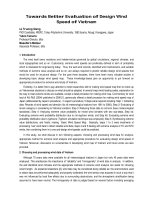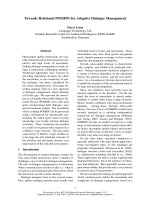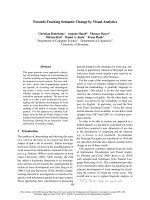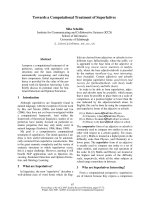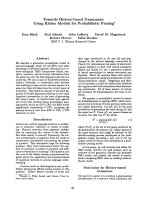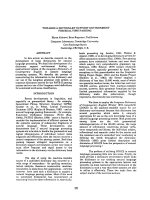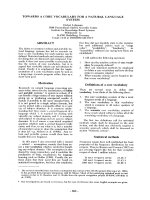Báo cáo khoa học: "Towards Abstract Categorial Grammars" pot
Bạn đang xem bản rút gọn của tài liệu. Xem và tải ngay bản đầy đủ của tài liệu tại đây (90.33 KB, 8 trang )
Towards Abstract Categorial Grammars
Philippe de Groote
LORIA UMR n
o
7503 – INRIA
Campus Scientifique, B.P. 239
54506 Vandœuvre l
`
es Nancy Cedex – France
Abstract
We introduce a new categorial formal-
ism based on intuitionistic linear logic.
This formalism, which derives from
current type-logical grammars, is ab-
stract in the sense that both syntax and
semantics are handled by the same set
of primitives. As a consequence, the
formalism is reversible and provides
different computational paradigms that
may be freely composed together.
1 Introduction
Type-logical grammars offer a clear cut between
syntax and semantics. On the one hand, lexical
items are assigned syntactic categories that com-
bine via a categorial logic akin to the Lambek cal-
culus (Lambek, 1958). On the other hand, we
have so-called semantic recipes, which are ex-
pressed as typed λ-terms. The syntax-semantics
interface takes advantage of the Curry-Howard
correspondence, which allows semantic readings
to be extracted from categorial deductions (van
Benthem, 1986). These readings rely upon a
homomorphism between the syntactic categories
and the semantic types.
The distinction between syntax and semantics
is of course relevant from a linguistic point of
view. This does not mean, however, that it must
be wired into the computational model. On the
contrary, a computational model based on a small
set of primitives that combine via simple compo-
sition rules will be more flexible in practice and
easier to implement.
In the type-logical approach, the syntactic con-
tents of a lexical entry is outlined by the following
patern:
<atom> : <syntactic category>
On the other hand, the semantic contents obeys
the following scheme:
<λ-term> : <semantic type>
This asymmetry may be broken by:
1. allowing λ-terms on the syntactic side
(atomic expressions being, after all, partic-
ular cases of λ-terms),
2. using the same type theory for expressing
both the syntactic categories and the seman-
tic types.
The first point is a powerfull generalization of
the usual scheme. It allows λ-terms to be used
at a syntactic level, which is an approach that
has been advocated by (Oehrle, 1994). The sec-
ond point may be satisfied by dropping the non-
commutative (and non-associative) aspects of cat-
egorial logics. This implies that, contrarily to
the usual categorial approaches, word order con-
straints cannot be expressed at the logical level.
As we will see this apparent loss in expressive
power is compensated by the first point.
2 Definition of a multiplicative kernel
In this section, we define an elementary gram-
matical formalism based on the ideas presented
in the introduction. This elementary formalism is
founded on the multiplicative fragment of linear
logic (Girard, 1987). For this reason, we call it
a multiplicative kernel. Possible extensions based
on other fragments of linear logic are discussed in
Section 5.
2.1 Types, signature, and λ-terms
We first introduce the mathematical apparatus that
is needed in order to define our notion of an ab-
stract categorial grammar.
Let A be a set of atomic types. The set T (A)
of linear implicative types built upon A is induc-
tively defined as follows:
1. if a ∈ A, then a ∈ T (A);
2. if α, β ∈ T (A), then (α −◦ β) ∈ T (A).
We now introduce the notion of a higher-order
linear signature. It consists of a triple Σ =
A, C, τ, where:
1. A is a finite set of atomic types;
2. C is a finite set of constants;
3. τ : C → T (A) is a function that assigns to
each constant in C a linear implicative type
in T (A).
Let X be a infinite countable set of λ-variables.
The set Λ(Σ) of linear λ-terms built upon a
higher-order linear signature Σ = A, C, τ is in-
ductively defined as follows:
1. if c ∈ C, then c ∈ Λ(Σ);
2. if x ∈ X, then x ∈ Λ(Σ);
3. if x ∈ X, t ∈ Λ(Σ), and x occurs free in t
exactly once, then (λx. t) ∈ Λ(Σ);
4. if t, u ∈ Λ(Σ), and the sets of free variables
of t and u are disjoint, then (t u) ∈ Λ(Σ).
Λ(Σ) is provided with the usual notion of cap-
ture avoiding substitution, α-conversion, and β-
reduction (Barendregt, 1984).
Given a higher-order linear signature Σ =
A, C, τ, each linear λ-term in Λ(Σ) may be as-
signed a linear implicative type in T (A). This
type assignment obeys an inference system whose
judgements are sequents of the following form:
Γ −
Σ
t : α
where:
1. Γ is a finite set of λ-variable typing declara-
tions of the form ‘x : β’ (with x ∈ X and
β ∈ T (A)), such that any λ-variable is de-
clared at most once;
2. t ∈ Λ(Σ);
3. α ∈ T (A).
The axioms and inference rules are the following:
−
Σ
c : τ(c) (cons)
x : α −
Σ
x : α (var)
Γ, x : α −
Σ
t : β
(abs)
Γ −
Σ
(λx. t) : (α −◦ β)
Γ −
Σ
t : (α −◦ β) ∆ −
Σ
u : α
(app)
Γ, ∆ −
Σ
(t u) : β
2.2 Vocabulary, lexicon, grammar, and
language
We now introduce the abstract notions of a vocab-
ulary and a lexicon, on which the central notion of
an abstract categorial grammar is based.
A vocabulary is simply defined to be a higher-
order linear signature.
Given two vocabularies Σ
1
= A
1
, C
1
, τ
1
and
Σ
2
= A
2
, C
2
, τ
2
, a lexicon L from Σ
1
to Σ
2
(in notation, L : Σ
1
→ Σ
2
) is defined to be a
pair L = F, G such that:
1. F : A
1
→ T (A
2
) is a function that inter-
prets the atomic types of Σ
1
as linear im-
plicative types built upon A
2
;
2. G : C
1
→ Λ(Σ
2
) is a function that interprets
the constants of Σ
1
as linear λ-terms built
upon Σ
2
;
3. the interpretation functions are compatible
with the typing relation, i.e., for any c ∈ C
1
,
the following typing judgement is derivable:
−
Σ
2
G(c) :
ˆ
F (τ
1
(c)),
where
ˆ
F is the unique homomorphic exten-
sion of F .
As stated in Clause 3 of the above defini-
tion, there exists a unique type homomorphism
ˆ
F : T (A
1
) → T (A
2
) that extends F . Simi-
larly, there exists a unique λ-term homomorphism
ˆ
G : Λ(Σ
1
) → Λ(Σ
2
) that extends G. In the se-
quel, when ‘L ’ will denote a lexicon, it will also
denote the homorphisms
ˆ
F and
ˆ
G induced by this
lexicon. In any case, the intended meaning will
be clear from the context.
Condition 3, in the above definition of a lexi-
con, is necessary and sufficient to ensure that the
homomorphisms induced by a lexicon commute
with the typing relations. In other terms, for any
lexicon L : Σ
1
→ Σ
2
and any derivable judge-
ment
x
0
: α
0
, . . . , x
n
: α
n
−
Σ
1
t : α
the following judgement
x
0
: L (α
0
), . . . , x
n
: L (α
n
) −
Σ
2
L (t): L (α)
is derivable. This property, which is reminis-
cent of Montague’s homomorphism requirement
(Montague, 1970b), may be seen as an abstract
realization of the compositionality principle.
We are now in a position of giving the defini-
tion of an abstract categorial grammar.
An abstract categorial grammar (ACG) is a
quadruple G = Σ
1
, Σ
2
, L , s where:
1. Σ
1
= A
1
, C
1
, τ
1
and Σ
2
= A
2
, C
2
, τ
2
are two higher-order linear signatures; Σ
1
is called the abstract vovabulary and Σ
2
is
called the object vovabulary;
2. L : Σ
1
→ Σ
2
is a lexicon from the abstract
vovabulary to the object vovabulary;
3. s ∈ T (A
1
) is a type of the abstract vocabu-
lary; it is called the distinguished type of the
grammar.
Any ACG generates two languages, an abstract
language and an object language. The abstract
language generated by G (A(G )) is defined as
follows:
A(G ) = {t ∈ Λ(Σ
1
) |
−
Σ
1
t: s is derivable}
In words, the abstract language generated by G
is the set of closed linear λ-terms, built upon the
abstract vocabulary Σ
1
, whose type is the distin-
guished type s. On the other hand, the object lan-
guage generated by G (O(G )) is defined to be the
image of the abstract language by the term homo-
morphism induced by the lexicon L :
O(G ) = {t ∈ Λ(Σ
2
) | ∃u ∈ A(G ). t = L (u)}
It may be useful of thinking of the abstract lan-
guage as a set of abstract grammatical structures,
and of the object language as the set of concrete
forms generated from these abstract structures.
Section 4 provides examples of ACGs that illus-
trate this interpretation.
2.3 Example
In order to exemplify the concepts introduced so
far, we demonstrate how to accomodate the PTQ
fragment of Montague (1973). We concentrate on
Montague’s famous sentence:
John seeks a unicorn (1)
For the purpose of the example, we make the two
following assumptions:
1. the formalism provides an atomic type
‘string’ together with a binary associative
operator ‘+’ (that we write as an infix op-
erator for the sake of readability);
2. we have the usual logical connectives and
quantifiers at our disposal.
We will see in Section 4 and 5 that these two as-
sumptions, in fact, are not needed.
In order to handle the syntactic part of the ex-
ample, we define an ACG (G
12
). The first step
consists in defining the two following vocabular-
ies:
Σ
1
= {n, np, s}, {J, S
re
, S
dicto
, A, U },
{J → np, S
re
→ (np −◦ (np −◦ s)),
S
dicto
→ (np −◦ (np −◦ s)),
A → (n −◦ np), U → n}
Σ
2
= {string}, {John, seeks, a, unicorn},
{John → string, seeks → string,
a → string, unicorn → string}
Then, we define a lexicon L
12
from the abstract
vocabulary Σ
1
to the object vocabulary Σ
2
:
L
12
= {n → string, np → string,
s → string},
{J → John,
S
re
→ λx. λy. x + seeks + y,
S
dicto
→ λx. λy. x + seeks + y,
A → λx. a + x,
U → unicorn}
Finally we have G
12
= Σ
1
, Σ
2
, L
12
, s.
The semantic part of the example is handled by
another ACG (G
13
), which shares with G
12
the
same abstract language. The object language of
this second ACG is defined as follows:
Σ
3
= {e, t},
{JOHN, TRY-TO, FIND, UNICORN},
{JOHN → e,
TRY-TO → (e −◦ ((e −◦ t) −◦ t)),
FIND → (e −◦ (e −◦ t)),
UNICORN → (e −◦ t)}
Then, a lexicon from Σ
1
to Σ
3
is defined:
L
13
= {n → (e −◦ t), np → ((e −◦ t ) −◦ t),
s → t},
{J → λP. P JOHN,
S
re
→
λP. λQ. Q (λx. P
(λy. TRY-TO y (λz. FIND z x))),
S
dicto
→
λP. λQ. P
(λx. TRY-TO x
(λy. Q (λz. FIND y z))),
A → λP. λQ. ∃x. P x ∧ Q x,
U → λx. UNICORN x}
This allows the ACG G
13
to be defined as
Σ
1
, Σ
3
, L
13
, s.
The abstract language shared by G
12
and G
13
contains the two following terms:
S
re
J (A U) (2) S
dicto
J (A U) (3)
The syntactic lexicon L
12
applied to each of these
terms yields the same image. It β-reduces to the
following object term:
John + seeks + a + unicorn
On the other hand, the semantic lexicon L
13
yields the de re reading when applied to (2):
∃x. UNICORN x ∧ TRY-TO JOHN (λz. FIND z x)
and it yields the de dicto reading when applied to
(3):
TRY-TO JOHN (λy. ∃x. UNICORN x ∧ FIND y x)
Our handling of the two possible readings
of (1) differs from the type-logical account of
Morrill (1994) and Carpenter (1996). The main
difference is that our abstract vocabulary con-
tains two constants corresponding to seek. Con-
sequently, we have two distinct entries in the se-
mantic lexicon, one for each possible reading.
This is only a matter of choice. We could have
adopt Morrill’s solution (which is closer to Mon-
tague original analysis) by having only one ab-
stract constant S together with the following type
assignment:
S → (np −◦ (((np −◦ s) −◦ s) −◦ s))
Then the types of J and A, and the two lexicons
should be changed accordingly. The semantic lex-
icon of this alternative solution would be simpler.
The syntactic lexicon, however, would be more
involved, with entries such as:
S → λx. λy. x + seeks + y (λz. z)
A → λx. λy. y (a + x)
3 Three computational paradigms
Compositional semantics associates meanings to
utterances by assigning meanings to atomic items,
and by giving rules that allows to compute the
meaning of a compound unit from the meanings
of its parts. In the type logical approach, follow-
ing the Montagovian tradition, meanings are ex-
pressed as typed λ-terms and combine via func-
tional application.
Dalrymple et al. (1995) offer an alternative to
this applicative paradigm. They present a deduc-
tive approach in which linear logic is used as a
glue language for assembling meanings. Their
approach is more in the tradition of logic pro-
gramming.
The grammatical framework introduced in the
previous section realizes the compositionality
principle in a abstract way. Indeed, it provides
compositional means to associate the terms of
a given language to the terms of some other
language. Both the applicative and deductive
paradigms are available.
3.1 Applicative paradigm
In our framework, the applicative paradigm con-
sists simply in computing, according to the lex-
icon of a given grammar, the object image of
an abstract term. From a computational point of
view it amounts to performing substitution and β-
reduction.
3.2 Deductive paradigm
The deductive paradigm, in our setting, answers
the following problem: does a given term, built
upon the object vocabulary of an ACG, belong
to the object language of this ACG. It amounts
to a kind of proof-search that has been de-
scribed by Merenciano and Morrill (1997) and by
Pogodalla (2000). This proof-search relies on lin-
ear higher-order matching, which is a decidable
problem (de Groote, 2000).
3.3 Transductive paradigm
The example developped in Section 2.3 suggests
a third paradigm, which is obtained as the com-
position of the applicative paradigm with the de-
ductive paradigm. We call it the transductive
paradigm because it is reminiscent of the math-
ematical notion of transduction (see Section 4.2).
This paradigm amounts to the transfer from one
object language to another object language, using
a common abstract language as a pivot.
4 Relating ACGs to other grammatical
formalisms
In this section, we illustrate the expressive power
of ACGs by showing how some other families of
formal grammars may be subsumed. It must be
stressed that we are not only interested in a weak
form of correspondence, where only the gener-
ated languages are equivalent, but in a strong form
of correspondence, where the grammatical struc-
tures are preserved.
First of all, we must explain how ACGs may
manipulate strings of symbols. In other words,
we must show how to encode strings as linear λ-
terms. The solution is well known: it suffices
to represent strings of symbols as compositions
of functions. Consider an arbitrary atomic type
∗, and define the type ‘string’ to be (∗ −◦ ∗).
Then, a string such as ‘abbac’ may be repre-
sented by the linear λ-term λx. a (b (b (a (c x)))),
where the atomic strings ‘a’, ‘b’, and ‘c’ are
declared to be constants of type (∗ −◦ ∗). In
this setting, the empty word () is represented
by the identity function (λx. x) and concatena-
tion (+) is defined to be functional composition
(λf. λg. λx. f (g x)), which is indeed an associa-
tive operator that admits the identity function as a
unit.
4.1 Context-free grammars
Let G = T, N, P, S be a context-free grammar,
where T is the set of terminal symbols, N is the
set of non-terminal symbol, P is the set of rules,
and S is the start symbol. We write L(G) for the
language generated by G. We show how to con-
struct an ACG G
G
= Σ
1
, Σ
2
, L , S correspond-
ing to G.
The abstract vocabulary Σ
1
= A
1
, C
1
, τ
1
is
defined as follows:
1. The set of atomic types A
1
is defined to be
the set of non-terminal symbols N.
2. The set of constants C
1
is a set of symbols in
1-1-correspondence with the set of rules P .
3. Let c ∈ C
1
and let ‘X → ω’ be the rule cor-
responding to c. τ
1
is defined to be the func-
tion that assigns the type [[ω]]
X
to c, where
[[·]]
X
obeys the following inductive defini-
tion:
(a) [[]]
X
= X;
(b) [[Y ω]]
X
= (Y −◦ [[ω]]
X
), for Y ∈ N;
(c) [[aω]]
X
= [[ω]]
X
, for a ∈ T .
The definition of the object vocabulary Σ
2
=
A
2
, C
2
, τ
2
is as follows:
1. A
2
is defined to be {∗}.
2. The set of constants C
2
is defined to be the
set of terminal symbols T .
3. τ
2
is defined to be the function that assigns
the type ‘string’ to each c ∈ C
2
.
It remains to define the lexicon L = F, G:
1. F is defined to be the function that interprets
each atomic type a ∈ A
1
as the type ‘string’.
2. Let c ∈ C
1
and let ‘X → ω’ be
the rule corresponding to c. G is de-
fined to be the function that interprets c as
λx
1
. . . . λx
n
. |ω|, where x
1
. . . x
n
is the se-
quence of λ-variables occurring in |ω|, and
| · | is inductively defined as follows:
(a) || = λx. x;
(b) |Y ω| = y + |ω|, for Y ∈ N, and where
y is a fresh λ-variable;
(c) |aω| = a + |ω|, for a ∈ T .
It is then easy to prove that G
G
is such that:
1. the abstract language A(G
G
) is isomorphic
to the set of parse-trees of G.
2. the language generated by G coincides with
the object language of G
G
, i.e., O(G
G
) =
L(G).
For instance consider the CFG whose produc-
tion rules are the following:
S → ,
S → aSb,
which generates the language a
n
b
n
. The cor-
responding ACG has the following abstract lan-
guage, object language, and lexicon:
Σ
1
= {S}, {A, B},
{A → S, B → ((S −◦ S)}
Σ
2
= {∗}, {a, b},
{a → string, b → string}
L = {S → string},
{A → λx. x, B → λx. a + x + b}
4.2 Regular grammars and rational
transducers
Regular grammars being particular cases of
context-free grammars, they may be handled by
the same construction. The resulting ACGs
(which we will call “regular ACGs” for the pur-
pose of the discussion) may be seen as finite state
automata. The abstract language of a regular
ACG correspond then to the set of accepting se-
quences of transitions of the corresponding au-
tomaton, and its object language to the accepted
language.
More interestingly, rational transducers may
also be accomodated. Indeed, two regular ACGs
that shares the same abstract language correspond
to a regular language homomorphism composed
with a regular language inverse homomorphism.
Now, after Nivat’s theorem (Nivat, 1968), any ra-
tional transducer may be represented as such a bi-
morphism.
4.3 Tree adjoining grammars
The construction that allows to handle the tree
adjoining grammars of Joshi (Joshi and Schabes,
1997) may be seen as a generalization of the con-
struction that we have described for the context-
free grammars. Nevertheless, it is a little bit more
involved. For instance, it is necessary to triplicate
the non-terminal symbols in order to distinguish
the initial trees from the auxiliary trees.
We do not have enough room in this paper for
giving the details of the construction. We will
rather give an example. Consider the TAG with
the following initial tree and auxiliary tree:
S
S
NA
{
{
{
{
{
{
C
C
C
C
C
C
a
S
|
|
|
|
|
|
|
B
B
B
B
B
B
B
d
b
S
∗
NA
c
It generates the non context-free language
a
n
b
n
c
n
d
n
. This TAG may be represented by the
ACG, G = Σ
1
, Σ
2
, L , S, where:
Σ
1
= {S, S
, S
}, {A, B, C},
{A → ((S
−◦ S
) −◦ S),
B → (S
−◦ ((S
−◦ S
) −◦ S
)),
C → (S
−◦ S
)}
Σ
2
= {∗}, {a, b, c, d},
{a → string, b → string,
c → string, d → string}
L = {S → string, S
→ string,
S
→ string},
{A → λf. f (λx. x),
B → λx. λg. a + g (b + x + c) + d,
C → λx. x}
One of the keystones in the above translation is
to represent an adjunction node A as a functional
parameter of type A
−◦ A
. Abrusci et al. (1999)
use a similar idea in their translation of the TAGs
into non-commutative linear logic.
5 Beyond the multiplicative fragment
The linear λ-calculus on which we have based
our definition of an ACG may be seen as a rudi-
mentary functional programming language. The
results in Section 4 indicate that, in theory, this
rudimentary language is powerful enough. Never-
theless, in practice, it would be useful to increase
the expressive power of the multiplicative kernel
defined in Section 2 by providing features such
as records, enumerated types, conditional expres-
sions, etc.
From a methodological point of view, there is
a systematic way of considering such extensions.
It consists of enriching the type system of the
formalism with new logical connectives. Indeed,
each new logical connective may be interpreted,
through the Curry-Howard isomorphism, as a new
type constructor. Nonetheless, the possible addi-
tional connectives must satisfy the following re-
quirements:
1. they must be provided with introduction and
elimination rules that satisfy Prawitz’s inver-
sion principle (Prawitz, 1965) and the result-
ing system must be strongly normalizable;
2. the resulting term language (or at least an in-
teresting fragment of it) must have a decid-
able matching problem.
The first requirement ensures that the new types
come with appropriate data constructors and dis-
criminators, and that the associated evaluation
rule terminates. This is mandatory for the applica-
tive paradigm of Section 3. The second require-
ment ensures that the deductive paradigm (and
consequently the transductive paradigm) may be
fully automated.
The other connectives of linear logic are natural
candidates for extending the formalism. In partic-
ular, they all satisfy the first requirement. On the
other hand, the satisfaction of the second require-
ment is, in most of the cases, an open problem.
5.1 Additives
The additive connectives of linear logic ‘&’ and
‘⊕’ corresponds respectively to the cartesian
product and the disjoint union. The cartesian
product allows records to be defined. The dis-
joint union, together with the unit type ‘1’, al-
lows enumerated types and case analysis to be
defined. Consequently, the additive connectives
offer a good theoretical ground to provide ACG
with feature structures.
5.2 Exponentials
The exponentials of linear logic are modal oper-
ators that may be used to go beyond linearity. In
particular, the exponential ‘!’ allows the intuition-
istic implication ‘→’ to be defined, which cor-
responds to the possibility of dealing with non-
linear λ-terms. A need for such non-linear λ-
terms is already present in the example of Sec-
tion 2.3. Indeed, the way of getting rid of the
second assumption we made at the beginning of
section 2.3 is to declare the logical symbols (i.e.,
the existential quantifier and the conjunction that
occurs in the interpretation of A in Lexicon L
13
)
as constants of the object vocabulary Σ
3
. Then,
the interpretation of A would be something like:
λP. λQ. EXISTS (λx. AND (P x) (Q x)).
Now, this expression must be typable, which is
not possible in a purely linear framework. Indeed,
the λ-term to which EXISTS is applied is not linear
(there are two occurrences of the bound variable
x). Consequently, EXISTS must be given ((e →
t) −◦ t) as a type.
5.3 Quantifiers
Quantifiers may also play a part. Uses of first-
order quantification, in a type logical setting, are
exemplified by Morrill (1994), Moortgat (1997),
and Ranta (1994). As for second-order quantifi-
cation, it allows for polymorphism.
6 Grammars as first-class citizen
The difference we make between an abstract vo-
cabulary and an object vocabulary is purely con-
ceptual. In fact, it only makes sense relatively to
a given lexicon. Indeed, from a technical point
of view, any vocabulary is simply a higher-order
linear signature. Consequently, one may think of
a lexicon L
12
: Σ
1
→ Σ
2
whose object lan-
guage serves as abstract language of another lex-
icon L
23
: Σ
2
→ Σ
3
. This allows lexicons to be
sequentially composed. Moreover, one may eas-
ily construct a third lexicon L
13
: Σ
1
→ Σ
3
that
corresponds to the sequential composition of L
23
with L
12
. From a practical point of view, this
means that the sequential composition of two lex-
icons may be compiled. From a theoretical point
of view, it means that the ACGs form a category
whose objects are vocabularies and whose arrows
are lexicons. This opens the door to a theory
where operations for constructing new grammars
from other grammars could be defined.
7 Conclusion
This paper presents the first steps towards the de-
sign of a powerful grammatical framework based
on a small set of computational primitives. The
fact that these primitives are well known from
programming theory renders the framework suit-
able for an implementation. A first prototype is
currently under development.
References
M. Abrusci, C. Fouquer
´
e, and J. Vauzeilles. 1999.
Tree-adjoining grammars in a fragment of the
Lambek calculus. Computational Linguistics,
25(2):209–236.
H.P. Barendregt. 1984. The lambda calculus, its syn-
tax and semantics. North-Holland, revised edition.
J. van Benthem. 1986. Essays in Logical Semantics.
Reidel, Dordrecht.
B. Carpenter. 1996. Type-Logical Semantics. MIT
Press, Cambridge, Massachussetts and London
England.
M. Dalrymple, M. Lamping, F. Pereira, and
V. Saraswat. 1995. Linear logic for meaning as-
sembly. In G. Morrill and D. Oehrle, editors, For-
mal Grammar, pages 75–93. FoLLI.
J Y. Girard. 1987. Linear logic. Theoretical Com-
puter Science, 50:1–102.
Ph. de Groote. 2000. Linear higher-order matching
is NP-complete. In L. Bachmair, editor, Rewriting
Techniques and Applications, RTA’00, volume 1833
of Lecture Notes in Computer Science, pages 127–
140. Springer.
A. K. Joshi and Y. Schabes. 1997. Tree-adjoining
grammars. In G. Rozenberg an A. Salomaa, editor,
Handbook of formal languages, volume 3, chap-
ter 2. Springer.
J. Lambek. 1958. The mathematics of sentence struc-
ture. Amer. Math. Monthly, 65:154–170.
J. M. Merenciano and G. Morrill. 1997. Generation as
deduction on labelled proof nets. In C. Retor
´
e, ed-
itor, Logical Aspects of Computational Linguistics,
LACL’96, volume 1328 of Lecture Notes in Artifi-
cial Intelligence, pages 310–328. Springer Verlag.
R. Montague. 1970a. English as a formal language.
In B. Visentini et al., editor, Linguaggi nella So-
ciet
`
a e nella Tecnica, Milan. Edizioni di Commu-
nit
`
a. Reprinted: (Montague, 1974, pages 188–221).
R. Montague. 1970b. Universal grammar. Theoria,
36:373–398. Reprinted: (Montague, 1974, pages
222–246).
R. Montague. 1973. The proper treatment of quan-
tification in ordinary english. In J. Hintikka,
J. Moravcsik, and P. Suppes, editors, Approaches to
natural language: proceedings of the 1970 Stanford
workshop on Grammar and Semantics, Dordrecht.
Reidel. Reprinted: (Montague, 1974, pages 247–
270).
R. Montague. 1974. Formal Philosophy: selected pa-
pers of Richard Montague, edited and with an intro-
duction by Richmond Thomason. Yale University
Press.
M. Moortgat. 1997. Categorial type logic. In J. van
Benthem and A. ter Meulen, editors, Handbook of
Logic and Language, chapter 2. Elsevier.
G. Morrill. 1994. Type Logical Grammar: Catego-
rial Logic of Signs. Kluwer Academic Publishers,
Dordrecht.
M. Nivat. 1968. Transduction des langages de Chom-
sky. Annales de l’Institut Fourier, 18:339–455.
R. T. Oehrle. 1994. Term-labeled categorial type sys-
tems. Linguistic & Philosophy, 17:633–678.
S. Pogodalla. 2000. Generation, Lambek Calculus,
Montague’s Semantics and Semantic Proof Nets. In
Proceedings of the 18
th
International Conference
on Computational Linguistics, volume 2, pages
628–634.
D. Prawitz. 1965. Natural Deduction, A Proof-
Theoretical Study. Almqvist & Wiksell, Stock-
holm.
A. Ranta. 1994. Type theoretical grammar. Oxford
University Press.
